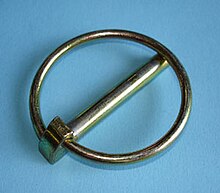
A wrench or spanner is a tool used to provide grip and mechanical advantage in applying torque to turn objects—usually rotary fasteners, such as nuts and bolts—or keep them from turning.

A shackle, also known as a gyve, is a U-shaped piece of metal secured with a clevis pin or bolt across the opening, or a hinged metal loop secured with a quick-release locking pin mechanism. The term also applies to handcuffs and other similarly conceived restraint devices that function in a similar manner. Shackles are the primary connecting link in all manner of rigging systems, from boats and ships to industrial crane rigging, as they allow different rigging subsets to be connected or disconnected quickly. A shackle is also the similarly shaped piece of metal used with a locking mechanism in padlocks. A carabiner is a type of shackle used in mountaineering.
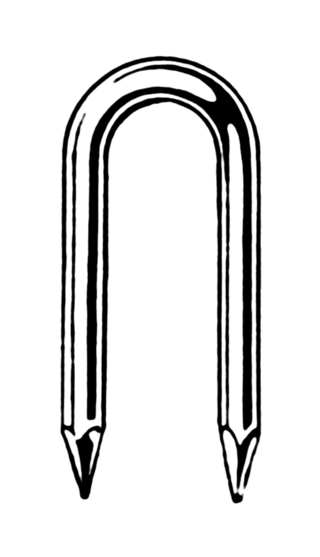
A staple is a type of two-pronged fastener, usually metal, used for joining, gathering, or binding materials together. Large staples might be used with a hammer or staple gun for masonry, roofing, corrugated boxes and other heavy-duty uses. Smaller staples are used with a stapler to attach pieces of paper together; such staples are a more permanent and durable fastener for paper documents than the paper clip.

A fastener or fastening is a hardware device that mechanically joins or affixes two or more objects together. In general, fasteners are used to create non-permanent joints; that is, joints that can be removed or dismantled without damaging the joining components. Steel fasteners are usually made of stainless steel, carbon steel, or alloy steel.

A clevis fastener is a two-piece fastener system consisting of a clevis and a clevis pin head. The clevis is a U-shaped piece that has holes at the end of the prongs to accept the clevis pin. The clevis pin is similar to a bolt, but is either partially threaded or unthreaded with a cross-hole for a split pin. A tang is a piece that is sometimes fitted in the space within the clevis and is held in place by the clevis pin. The combination of a simple clevis fitted with a pin is commonly called a shackle, although a clevis and pin is only one of the many forms a shackle may take.
Clip or CLIP may refer to:

A split pin, also known in the US as a cotter pin or cotter key, is a metal fastener with two tines that are bent during installation, similar to a staple or rivet. Typically made of thick wire with a half-circular cross section, split pins come in multiple sizes and types.

A safety wire or locking-wire is a type of positive locking device that prevents fasteners from falling out due to vibration and other forces. The presence of safety wiring may also serve to indicate that the fasteners have been properly tightened.

A pintle is a pin or bolt, usually inserted into a gudgeon, which is used as part of a pivot or hinge. Other applications include pintle and lunette ring for towing, and pintle pins securing casters in furniture.

A castellated nut, sometimes referred to as a castle nut, is a nut with slots (notches) cut into one end. The name comes from the nut's resemblance to the crenellated parapet of a medieval castle. Castellated nuts are sometimes referred to incorrectly as castigated nuts.
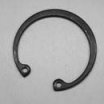
A circlip, also known as a C-clip, snap ring, or Jesus clip, is a type of fastener or retaining ring consisting of a semi-flexible metal ring with open ends that can be snapped into place into a machined groove on a dowel pin or other part to permit rotation but to prevent axial movement. There are two basic types of circlips: internal and external. Circlips are often used to secure pinned connections.

A cotter is a pin or wedge passing through a hole to fix parts tightly together. In British usage cotter pin has the same meaning, but in the U.S. it means a split pin.
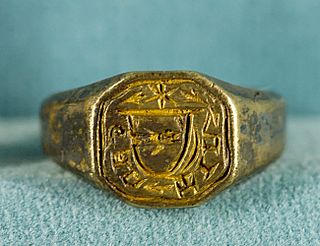
A bezel is a wider and usually thicker section of the hoop of a ring, which may contain a gem or a flat surface. Rings are normally worn to display bezels on the upper or outer side of the finger. In gem-cutting the term bezel is used for those sloping facets of a cut stone that surround the flat table face, which is the large, horizontal facet on the top.
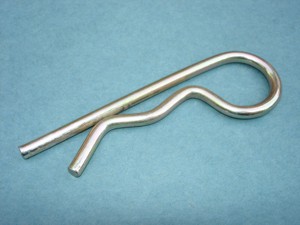
An R-clip, also known as an R-pin, R-key, hairpin cotter pin, hairpin cotter, bridge pin, hitch pin clip or spring cotter pin, is a fastener made of a durable but flexible material, commonly hardened metal wire, resembling the shape of the letter "R".

A spring pin is a mechanical fastener that secures the position of two or more parts of a machine relative to each other. Spring pins have a body diameter which is larger than the diameter of the hole they are intended for, and a chamfer on either one or both ends to facilitate starting the pin into the hole. The spring action of the pin allows it to compress as it assumes the diameter of the hole. The force exerted by the pin against the hole wall retains it in the hole, therefore a spring pin is considered a self retaining fastener.

A circle cotter, also known as a cotter ring or split ring, is a formed wire fastener that is shaped like a circle, hence the name. The open end of the wire is in the middle of the cotter so when it is installed the inner tab is first installed in the hole. Because of this feature it is often used in applications where a sharp edge cannot be tolerated, such as fabric applications.

Machine element or hardware refers to an elementary component of a machine. These elements consist of three basic types:
- structural components such as frame members, bearings, axles, splines, fasteners, seals, and lubricants,
- mechanisms that control movement in various ways such as gear trains, belt or chain drives, linkages, cam and follower systems, including brakes and clutches, and
- control components such as buttons, switches, indicators, sensors, actuators and computer controllers.

A positive locking device is a device used in conjunction with a fastener in order to positively lock the fastener. This means that the fastener cannot work loose from vibrations. The following is a list of positive locking devices:
7-122. GENERAL. The word safetying is a term universally used in the aircraft industry. Briefly, safetying is defined as: "Securing by various means any nut, bolt, turnbuckle etc., on the aircraft so that vibration will not cause it to loosen during operation." These practices are not a means of obtaining or maintaining torque, rather a safety device to prevent the disengagement of screws, nuts, bolts, snap rings, oil caps, drain cocks, valves, and parts. Three basic methods are used in safetying; safety-wire, cotter pins, and self-locking nuts. Retainer washers and pal nuts are also sometimes used.
7-124d. Safety wire must be installed in a manner that will prevent the tendency of the part to loosen.

